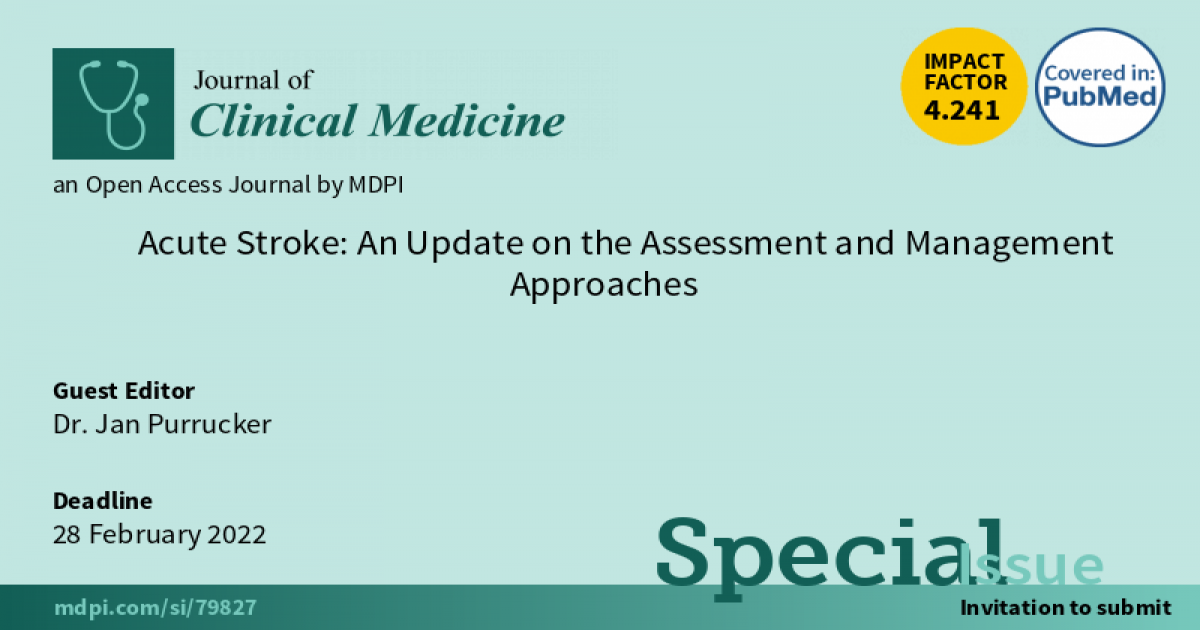- 2.9Impact Factor
- 5.2CiteScore
- 18 daysTime to First Decision
Acute Stroke: An Update on the Assessment and Management Approaches
This special issue belongs to the section “Clinical Neurology“.
Special Issue Information
Dear Colleagues,
Recent technological and medical advances have changed the assessment and management of acute ischemic and hemorrhagic stroke. In ischemic stroke, there is a lot of effort done in streamlining the process in emergency care, including the use of prehospital triage and telemedicine. Optimizing the assessment of heart rhythm disorders, with focus on atrial fibrillation, is still in the scope of clinical interest, and many questions remain unanswered.
For acute hemorrhagic stroke, management has focused on blood pressure control, as well as control of coagulation. In both ischemic and hemorrhagic stroke, rapid management of coagulation in patients with oral anticoagulation including non-vitamin K antagonists oral anticoagulants place a pivotal yet challenging role in emergency assessment of patients. During the world-wide pandemic situation due to COVID-19, management of acute stroke has become especially challenging, but innovative concepts have developed.
We are pleased to invite you to submit manuscript covering basic research, clinical research, and (systematic) reviews or a metaanalysis to the Special Issue.
The aim of this Special Issue is to boundle articles focusing primarily on the acute prehospital and inhospital phase of stroke with regard to assessment and management, but the Guest Editor is open to consider manuscripts, focusing on the bridge towards post-acute care as well.
I look forward to receiving your contributions.
Dr. Jan Purrucker
Guest Editor
Manuscript Submission Information
Manuscripts should be submitted online at www.mdpi.com by registering and logging in to this website. Once you are registered, click here to go to the submission form. Manuscripts can be submitted until the deadline. All submissions that pass pre-check are peer-reviewed. Accepted papers will be published continuously in the journal (as soon as accepted) and will be listed together on the special issue website. Research articles, review articles as well as short communications are invited. For planned papers, a title and short abstract (about 100 words) can be sent to the Editorial Office for announcement on this website.
Submitted manuscripts should not have been published previously, nor be under consideration for publication elsewhere (except conference proceedings papers). All manuscripts are thoroughly refereed through a single-blind peer-review process. A guide for authors and other relevant information for submission of manuscripts is available on the Instructions for Authors page. Journal of Clinical Medicine is an international peer-reviewed open access semimonthly journal published by MDPI.
Please visit the Instructions for Authors page before submitting a manuscript. The Article Processing Charge (APC) for publication in this open access journal is 2600 CHF (Swiss Francs). Submitted papers should be well formatted and use good English. Authors may use MDPI's English editing service prior to publication or during author revisions.
Keywords
- Stroke
- Ischemic Stroke
- Hemorrhagic Stroke
- Intracranial Bleeding
- Intracerebral hemorrhage
- thrombectomy
- thrombolysis
- telemedicine
- teleneurology
- telestroke
- anticoagulation

Benefits of Publishing in a Special Issue
- Ease of navigation: Grouping papers by topic helps scholars navigate broad scope journals more efficiently.
- Greater discoverability: Special Issues support the reach and impact of scientific research. Articles in Special Issues are more discoverable and cited more frequently.
- Expansion of research network: Special Issues facilitate connections among authors, fostering scientific collaborations.
- External promotion: Articles in Special Issues are often promoted through the journal's social media, increasing their visibility.
- e-Book format: Special Issues with more than 10 articles can be published as dedicated e-books, ensuring wide and rapid dissemination.

